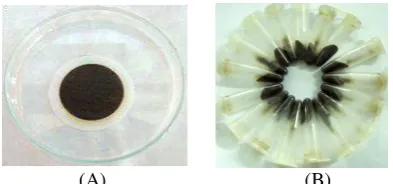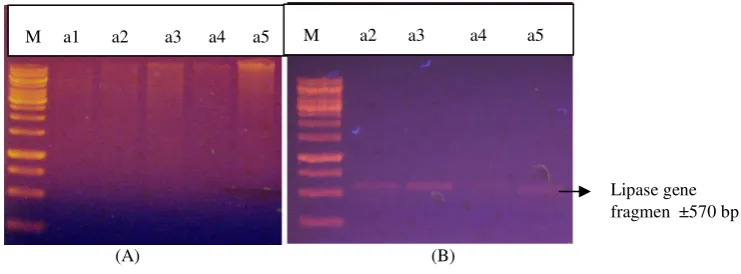Volume 1677: The 5th International Conference on
Mathematics and Natural Sciences
Edited by Acep Purqon, Taufiq Hidayat, Reuben Jih-Ru Hwu, and Hidetaka
Arimura
Number of Volumes:
1
ISBN:
9780735413245
Volume 1677 is the proceedings of
The 5th International Conference on Mathematics and Natural
Sciences
(2
–
3 November 2014, Bandung, Indonesia)
Amplification of Thermostable Lipase Genes Fragment
From Thermogenic Phase of Domestic Waste
Composting Process
Nurhasanah
1,2), Santi Nurbaiti
1), Fida Madayanti
1), Akhmaloka
1)1)Biochemistry Research Group, FMIPA, ITB, Jalan Ganesha 10, Bandung 40132, Indonesia
2)Department Chemistry, FMIPA, Lampung University, Indonesia
Coresponding author : [email protected]; [email protected]; [email protected];
[email protected]
Abstract. Lipases are lipolytic enzymes, catalyze the hydrolysis of fatty acid ester bonds of triglycerides to produce free fatty acids and glycerol. The enzyme is widely used in various fields of biotechnological industry. Hence, lipases with unique properties (e.g.thermostable lipase) are still being explored by variation methods. One of the strategy is by using metagenomic approach to amplify the gene directly from environmental sample. This research was focused on amplification of lipase gene fragment directly from the thermogenic phase of domestic waste composting in aerated trenches. We used domestic waste compost from waste treatment at SABUGA, ITB for the sample. Total chromosomal DNA were directly extracted from several stages at thermogenic phase of compost. The DNA was then directly used as a template for amplification of thermostable lipase gene fragments using a set of internal primers namely Flip-1a and Rlip-1a that has been affixed with a GC clamp in reverse primer. The results showed that the primers amplified the gene from four stages of thermogenic phase with the size of lipase gene fragment of approximately 570 base pairs (bp). These results were further used for Denaturing Gradient Gel Electrophoresis (DGGE) analysis to determine diversity of thermostable lipase gene fragments.
Key words : PCR, lipase, metagenomic approach, compost
1. Introduction
Lipase (triacylglycerol acylhydrolases , EC 3.1.1.3) is a lipolytic enzyme that functions to hydrolyze carboxylic ester bonds
triglycerides to produce fatty acids and glycerol. Lipase is widely used in various fields such as food industry, detergents
biology, medical fields, sewage treatment, organic synthesis, hydrolysis of fats and oils, modified fat, flavor enhancer in
food processing, the resolution of racemic mixtures and chemical analysis, the leather industry, also in the pulp industry
and paper [1, 2]. In addition, the lipase can also be utilized in increasing degradation of wastes containing fats and
polyurethane. The broad applications of lipase is due to several things including: lipase has a broad substrate specificity,
stable in organic solvents and possess high regio-selectivity [2].
Indonesia is a country that has a high biodiversity. The presence of geothermal area in natural and artificial widespread
allow for obtaining thermophilic microbes with high diversity. Research to obtain thermophilic bacteria producing
thermostable enzymes have been carried out through cultivation techniques. However, only less than 1 % of microbe have
been successfully cultivated because of the limitations and the difficulty of finding a selective medium for microbial
growth. One method that is currently done is metagenomic approach which involve isolation of microbial genomes
directly from natural samples without cultivation. Metagenome approach is a relatively new method in an attempt to find
the source of thermostable enzymes. Some studies of lipase obtained through metagenome approaches such as lipase from
sediment [3], soil [4], and activated sludge [5]. Through this approach, it is possible to get different variants of the lipase
Compost is the artificial geothermal environment that consists of organic material from domestic waste. During the
composting process, the organic components are biochemically decomposed by mesophilic and thermophilic bacteria
under aerobic conditions, where the thermostable enzyme such as lipase plays an important role in this stage [6]. During
the process, the compost will experience changes in temperature, pH, and the structure of organic materials [7]. Research
on microorganisms on various types of compost has also been carried out and shows the diversity of microorganisms and
enzymes produced in each phase of composting [8, 9].
Here we report, the presence of a lipase gene fragments from thermogenic phase of composting domestic waste treatment
has been successfully amplified using primers internal lipase gene that were designed and reported in previous studies
[10].
2. Materials and Methods
3. Composting and sampling
Compost sample was taken from composting process at TPS Sabuga, ITB, Bandung with the distance at around 1 km
from the Biochemistry Laboratory. The composting process use domestic waste as compost material with traditional
process. 1-2 kg compost of thermogenic phase at temperature around 45-67 oC was collected from about 30 cm of compost
surface. Samples were immediately used for further analysis.
4. Preparation of sample
Water extracts of the compost samples were prepared by shaking approximately 30 grams of the fresh sample in 270 ml
of sterile distilled water with horizontal shaker for 30 minutes and then filtered. Water extract was re-filtered through a
0.22-µm-pore-size cellulose membrane filter (Sartorius, Germany). Microbes pellet in the membrane was resuspended in
STE buffer (10 mM Tris-HCl pH 8.0, 0.1 M NaCl, 1 mM EDTA) and then stored at -20 oC until used for DNA isolation.
5. Isolation of total DNA
Total DNA from samples were extracted using the Power soil DNA isolation kit (MO BIO Laboratories, Inc., California)
according the manufacture instruction. The DNA was stored at -20 oC until use.
6. Amplification of Thermostable lipase gene Fragments
The partial of lipase genes was amplified by using a set of primers namely Flip-1a (5’TGATCG GCCACAGTCAGGG 3’) and Rlip-1a with 39 base GC clamp incorporated (5’CgCCCgCCgCgCCCCgCgCCCggCCCgCCgCCCCCgCCC GTTGATCTCGTCGATATGGTT 3’). PCR was performed by using Sso fast evagreen supermixe according to the
instruction provided from the manufacturer (Biorad). Amplification was performed with PCR within 35 cycles denaturing
at 98 oC for 30 second, annealing at 55 oC for a 30 second, extension at 72 oC for a minute and final extension at 72 oC
for 10 minutes. PCR product was then examined with ethidium bromide-stained agarose gel.
7. Results and Discussion
Lipase is a class of hydrolases that play an important role in the industrial world. Based on amino acid sequence homology,
lipase bacteria are classified into eight families [11]. Family I is a “true lipase” producing bacteria group consisting of 6
subfamily. Two of the four regions conserved in sub family 1.1 and 1.2 has been used to design primers which are
containing catalytic triad of the amino acid lipase i.e serine and histidine. This internal primer was designed to amplify
Composting process are carried out in the Waste Sites (TPS) Sabuga, ITB, Jalan Taman Sari No. 73 Lebak Siliwangi,
Bandung. Composting was done traditionally without using starter and aeration system otomatic. The compost pile is
made with a length x width x height = 100 cm x 100 cm x 100 cm. The highest temperature was reach at the 18th day (67 oC) and then fell gradually until the maturation process was completed during the composting process. The compost
profile and sampling points on the thermogenic phase can be seen in Figure 1.
Figure 1. The compost profile and sampling point during thermogenic phase.
(a1-a5 = sampling point at a1=45 oC, a2= 56 oC, a3= 60,5 oC, a4= 67 oC and a5= 65 oC)
In this research, the composts were taken from each sampling point, then suspended and filtered through Millipore 0,22 µ m
membrane to collect the cell (Figure 2A). The filtration result of compost samples was showed as blackish brown cell,
indicating the high presence of humic acid in the samples [12]. Furthermore, a collection of microbial cells were resuspended
to STE buffer and collected in 2 mL microtube to be stored at -20°C or to be extracted (Figure 2B).
(A)
(B)
Figure 2. Cells compost which is a collection of microbial cells. (A) The cell using a membrane filtration
(B) The cell was washed with STE buffer
Total community DNA from each samples was isolated from the cells and examined under agarose gel electrophoresis. It
showed a single band on ethidium bromide-stained agarose gel (Figure 3A) and it has a relatively high purity in the absence
of other bands and RNA were detected on the agarose gel. This DNA then used as template for amplification, in which the
DNA template used is a mixture of compost microbe. We have successfully amplified the fragment by using primer pair
Flip-1a and Rlip-Flip-1a that has been affixed with a GC clamp to amplify lipase gene fragment. Mixture of total community DNA
has been successfully used as template to amplify the lipase gene. The PCR products were then tested with the agarose gel
(A) (B)
Figure 3. Electrophoregram of total DNA community and lipase gene fragment from some sampling point. (A) Electrophoregram of total DNA community from some sampling point (M=marker 1kb DNA
ladder; a1-a5 = total community chromosomal DNA from sampling point a1-a5)
(B) Electrophoregram of lipase gene fragment from some sampling point ((M=marker 1kb DNA ladder; a2-a5 = lipase gene fragment at sampling point a2-a5)
Based on the results of electrophoresis in 1% agarose with ethidium bromide addition (Figure 3B), the presence of DNA bands
visible at 2,3 4 and 5 points (for 1 point not showed) of composting with the size of ± 570 bp. It shows that the primers
designed has been successfully used to amplify lipase gene fragment of total comunity DNA from natural samples.
8. Conclusion
The designed primer was successfully used to amplify lipase gene fragment from total chromosomal DNA isolated from
compost samples at some point in the thermogenic phase.
9. References
[1] Jaeger, K. E., Reetz, M. T. 1998. Microbial Lipases Form Versatile Tools for Biotechnology. Trends Biotechnol. 16. 396- 403.
[2] Sharma, R., Chisti, Y., Banerjee, U.C. 2001. Production, Purification, Characterization and Application of Lipases. Biotechnology Advances. 19. 627-662.
[3] Lee, M.H., Lee, C.H., Oh, T.K., Song, J.K. 2006. Isolation and Characterization of a Novel Lipase from a Metagenomic Library of Tidal Flat Sediments : Evidence for a New Family of Bacterial Lipases. Appl. Environ. Microbiol. 72. 7406- 7409.
[4] Bunterngsook, B., Kanokratana, P., Thongaram, T., Tanapongpipat, S., Uengwetwanit, T., Rachdawong, S., Vichitsoonthonkul, T., Eurwilaichitr, L. 2010. Identification and Characterization of Lipolytic Enzymes from a Peat- Swamp Forest Soil Metagenome. Biosci. Biotechnol. Biochem. 74 (9). 1848-1854.
[5] JunGang, L., Kegui, Z., Wenjun, H. 2010. Cloning and Biochemical Characterization of a Novel Lipolytic Gene from Activated Sludge Metagenome, and Its Gene Product. Microbial Cell Factories. 9: 83. 1-9.
[6] Ishii, K., Takii, S. 2003. Comparison of Microbial Communities in Four Different Composting Processes as Evaluated by Denaturing Gradient. Journal of Applied Microbiology. 95. 109-119.
[7] Veeken, H.M., Adani, F., Nierop, K.G.J., de Jager, P.A., Hamelers, H.V.M. 2001. Degradation of Biomacromolecules During High-Rate Composting of Wheat Strwa-Amended Feces. J. Environmen. Qual. 30. 1675-1684.
[8] Tiquia, S.M. 2010. Evolution of Extracellular Enzyme Activities During Manure Composting. Journal of Applied Microbiol. 92. 764-775.
[9] Partanen, P., Hultman, J., Paulin,L., Auvinen, P.,Romansthuck, M. 2010.Bacterial diversity a different stages of the Composting Process. BMC Microbiol. 1094. 1-11.
[10] Nurhasanah, Nurbaiti, S., Madayanti, F., Akhmaloka, 2014. Internal Primer Design for Diversity Study of Thermostable Lipase Gene Fragment from Environmental Sample. Seminar Nasional Biokimia UIN Syarif Hidayatullah, Jakarta.
M a1 a2 a3 a4 a5 M a2 a3 a4 a5
[11] Arpigny, J. L., Jaeger, K. E. 1999. Bacterial Lipolytic Enzymes: Classification and Properties. Biochem. J. 343. 177- 183.

